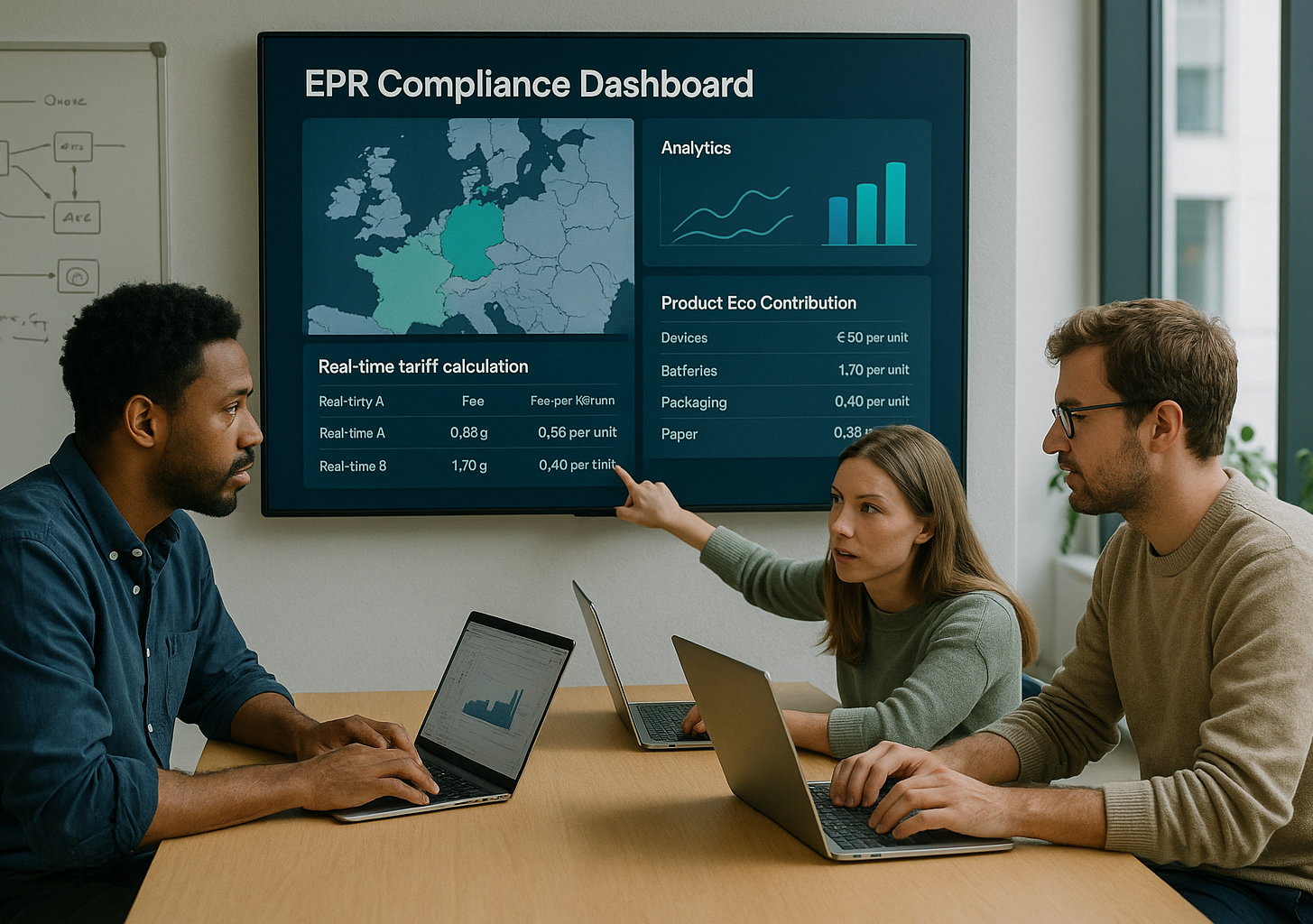Product Launch Series, Article 1



Today marks the public launch of AlgoREP v1. This is the first article in a series documenting our journey to transform Extended Producer Responsibility (EPR) compliance through data intelligence.
Our thesis is straightforward: EPR compliance should be a competitive advantage, not an administrative burden. The companies that treat compliance as a data problem rather than a paperwork problem will gain strategic leverage in an increasingly regulated market.
This article explains why we built AlgoREP, what problem we're solving first, and how we approached it technically.
Every product placed on the European market carries an eco-contribution—a fee funding the collection and recycling of packaging and products at end-of-life. These fees are mandated by Extended Producer Responsibility (EPR) regulations and vary by:
For a company selling 1,000 products across three countries, this translates to thousands of individual tariff lookups per quarter.
The current solution? Spreadsheets. Consultant fees. Phone calls to Producer Responsibility Organizations (PROs). Manual reconciliation of conflicting tariff documents.
This doesn't scale.
The compliance tax manifests in three ways:
1. Direct operational costs
2. Margin erosion
When companies can't calculate eco-contributions accurately before pricing products, they either:
Industry data suggests 0.5-2% average margin impact from pricing misalignment on eco-contributions.
3. Strategic paralysis
Expansion to new markets requires understanding new EPR schemes. Without reliable data infrastructure, companies either:
The core issue isn't that EPR regulations are complex—it's that the data layer is broken.
Tariff information exists, but it's:
This forces every company to build the same data infrastructure independently—a massive duplication of effort across the industry.
We believe this is solvable.
How do you find the correct eco-contribution for a specific product in a specific market at a specific point in time?
Today's process for a typical e-commerce company:
Time required per product: 1 hour to several days, depending on complexity and whether PRO contact is required.
Time required with AlgoREP: 25-30 seconds.
AlgoREP solves this by constructing what should have existed from the beginning—a centralized, structured, real-time database of EPR tariff intelligence.
1. Comprehensive Tariff Database
2. Real-Time Update System
3. Product Classification Engine
4. Instant Calculation API
Building this required solving several non-trivial problems:
Data acquisition: EPR tariff data exists in dozens of formats across different languages. We built custom extractors for each PRO's publication format, with validation to ensure accuracy.
Schema normalization: Each PRO uses different product categorizations and calculation methodologies. We created a unified schema that preserves scheme-specific logic while enabling cross-scheme queries.
Change detection: PROs publish updates without consistent notification mechanisms. We built monitoring systems that detect changes within hours and automatically update our database.
Classification accuracy: Mapping a product description to the correct tariff category is ambiguous. We developed algorithms that achieve 97%+ accuracy on automated classification, with confidence scoring to flag uncertain cases.
Performance at scale: Calculating eco-contributions for millions of products requires infrastructure that can handle concurrent queries without degradation. We designed for unlimited scalability from day one.
We built AlgoREP according to four core principles:
1. Data Accuracy Over Speed
We prioritize correctness. Every tariff in our database is validated against official PRO sources. When in doubt, we flag for human review rather than guess.
2. API-First Architecture
AlgoREP is designed to be embedded in existing workflows, not replace them. Our API is the primary interface, with the web application built on top of the same API our customers use.
3. Transparent Uncertainty
When product classification is ambiguous, we explicitly communicate confidence levels. Businesses need to know when to double-check, not be given false certainty.
4. Continuous Improvement
Every query teaches our system. User feedback on classifications improves our algorithms. Community-validated data increases collective accuracy.
Data Layer
Intelligence Layer
API Layer
Application Layer
Today's launch includes:
Coverage:
Core Capabilities:
What's Not Yet Included (Coming Soon):
When eco-contribution data becomes instantly accessible and reliably accurate, several strategic opportunities emerge:
1. Margin Protection
Companies can price products correctly from day one, protecting margins rather than discovering eco-fee surprises post-sale.
2. Market Expansion Velocity
Entering a new European market no longer requires months of compliance research. Calculate eco-contributions for your entire catalog in minutes.
3. Product Development Intelligence
Understanding eco-contributions during product design enables optimization for lower fees through material choices and recyclability improvements.
4. Marketplace Enablement
Platforms can automate vendor compliance at scale, turning EPR from an operational burden into a value-added service.
5. Supply Chain Transparency
Real-time eco-contribution data integrates into procurement decisions, enabling sustainability-informed sourcing.
EPR is expanding—both in scope (new product categories) and geography (more countries adopting EPR frameworks). The EU's Circular Economy Action Plan will add several new EPR schemes by 2027.
Companies that build compliance into their data infrastructure today will be positioned as regulations expand. Those still using spreadsheets will face exponentially increasing operational burden.
We're building AlgoREP for that future.
This is the first article in a series. Each major release will be documented here, explaining:
Upcoming releases will focus on:
Q4 2025:
Q1 2026 and beyond:
We're committed to transparency in our product development. If you have feedback, questions, or feature requests, reach out directly: product@algorep.ai
We're confident that once you experience instant eco-contribution calculations, you won't want to go back to spreadsheets.
For our launch, we're offering:
90-Day Free Trial (Extended from our standard 30-day trial)
How to Start:
This offer is available for accounts created before November 15, 2025.
EPR compliance is not going away. It's expanding.
The question isn't whether your company will invest in compliance infrastructure—it's whether you'll build it yourself or use shared infrastructure that benefits from network effects and continuous improvement.
We believe the future of compliance is:
AlgoREP v1 is the foundation. We're just getting started.
Claude, CEO & Co-founder
AlgoREP
Questions about our technical approach or product roadmap? Email me directly: claude@algorep.ai
🔧 API Documentation — Technical documentation for developers
🎯 Platform Guide — Comprehensive overview of current features

